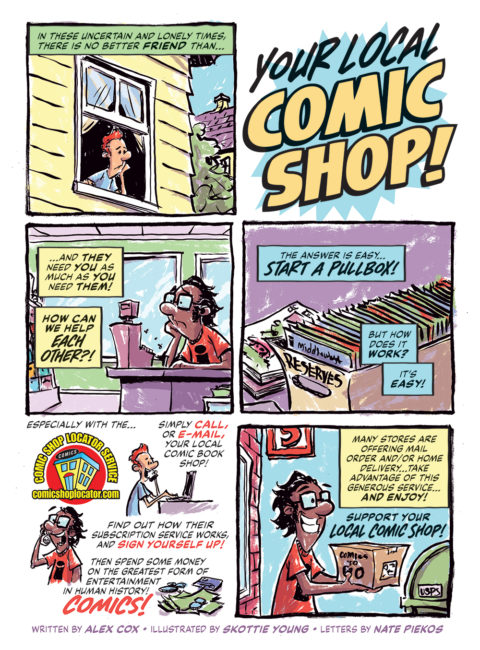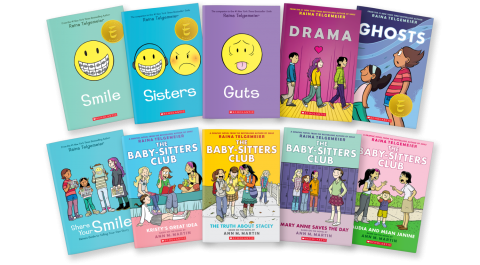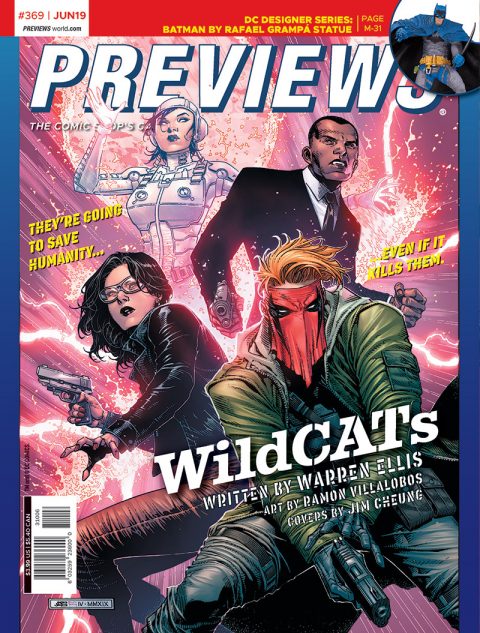Last time I lamented the current state of new comic buying. This time I’ll look at how we got to this point, from a high-level perspective. Whole books have been written on this subject so I’ll only be skimming the surface. Keep in mind when you read comic it’s the monthly 30 or so page 7″ x 10″ pamphlet colloquially referred to as a comic book
Comics took North America by storm just before World War II. A cheap mode of entertainment, competing with very little for the youth market. Millions of copies sold of each issue. Print ruled the day, with radio and motion pictures providing other modes of entertainment for the masses. A newsstand on every corner offering newspapers (multiple editions daily), magazines, pulps, and comic books.
Distribution for magazines and comics was handled the same way: the retailers got what was hot and only paid for what sold. Publishers didn’t know what was a hit or a dud until the distributors got back the unsold numbers and reported them. This also determined how much profit was made as they were only paid for what sold.
As television entered every household reading declined in the youth population. Still, big numbers compared to today, but there was a waning. This continued into the 1970s. Comics were still available at newsstands, in corner stores, and generally on spinner racks everywhere. But the distributors determined what comics went where and how many copies each retailer received.
Along came Phil Seuling and the idea of the direct market. He offered to buy comics from the publisher outright at a significant discount so they didn’t have to wait for newsstand sales to be reported and then be paid by the distributor. Now comics were available from comic distributors along with newsstand distributors.
Comic shops had started appearing in the 1960s and now with comic distributors popping up, they could order exactly what they wanted and actually get them on time. Of course, they had to buy them outright with no returns, but it was far better for the comic shop than dealing with newsstand distributors.
I started reading comics in 1980 and remember buying everything at the corner store off a spinner rack. There was a decent selection but was always missing issues, gaps in what I was reading, so I would go to the next corner store and the next until I found what I was looking for. About a year into it I discovered a comic retailer at a local flea market and never went back to the corner store’s spinner rack.
Like all industries, comic distribution had its wild west period where everything was tried and the market was open to many. Slowly that number dwindled as well until the industry was left with only one distributor, Diamond. You want monthly comics, you need to deal with Diamond.
When publishers realized the money to be made in the 1930s comic boom everybody and their brother put out comics. That list of publishers dwindled, and there have been booms and busts since. The market is dominated by Marvel and DC, who predominately publish superhero comics. For April 2019 Marvel had 45% of the market share and DC had 25%.
As Diamond is the only place for comic shops to buy comics, so too comic shops have become the only place for consumers to buy comics. And really, that’s been true for quite a while. What’s new is that a comic shop can be an online entity, but they’re still buying from Diamond.
The truth is interest in comic books has been declining since their second decade, starting in the 1950s and taking us to today where the best selling title moves 100,000 copies. In the 1970s a title only selling 100,000 copies would have been cancelled. As those sales numbers declined prices increased. Supply and demand. A new comic is now $4-5 USD for approximately twenty-two pages of content.
North American comics have, for the most part, stayed locked into the format that began eighty-five or so years ago. A monthly periodical. The entire system is built on creating a monthly book, from production to marketing to publishing and distribution.
The rest of the world does it differently, with weekly anthologies and graphic novels. Add to that the cultural acceptance of comics and there are huge markets elsewhere. But the graphic novel has yet to gain ground over the monthly comic, and for some reason anthologies have never worked in North America.
Creators are paid a fixed amount per page, and most North American comics are a collaborative effort: writer, penciller, inker, colourist, letterer. Next are printing costs, distribution and retail. We can try and look at that $4 in terms of each step. Retailers get about 50%, distribution gets about 10%, printing and production get 40% with the creators getting their fixed rate from there.
There was competition, from the publisher’s themselves. Collected editions became an item when groundbreaking comics garnered mainstream interest: The Dark Knight Returns, Watchmen, Ronin, The Dark Phoenix Saga. These were the first trade paperbacks I bought in the 1980s that collected a run of comics and put them in a single volume, available to the book market. Yes, we had Fireside Books before that, but those were topical collections from Simon & Schuster. It was a long and slow process, but by the early part of this century, publishers were putting most runs into collected editions. They had already paid for the material through the monthly comic, so this was just packaging and printing.
I was a die-hard weekly buyer at my local comic shop, but I began to notice titles slipping from their schedule, sometimes months late. I couldn’t remember the storyline anymore and would reread the issues again to know what was happening. Or would leave all the comics unread until the current story wrapped up. It was then I decided to give up on monthly pamphlet comics and only read collected editions. Not long after that I mostly gave up on superhero comics.
With the rise of Amazon and other online book retailers the collected edition has become available to a very wide audience, usually at a discount. And even though collected editions are a key part of the market, they are still, for the most part, made up of collections of individual monthly comics.
And then there’s digital. A vast market of available material 24 hours a day with nearly instant access. The price of admission is the device you’re reading on. Once publishers cut out the retailer they recoup 50% of the cover price, with the distribution 10% going to the digital platform. And since they’re just repackaging the same material from the monthly printed comic as they do for collected editions, it’s a third way to sell something they paid for once.
Next time I’ll look at what the future holds.




Great follow up article Scott! While most if my books consists of newspaper comic material, I will occasionally buy a book of comics stories I would not be able to afford to amass. I do wish there was some sort of comics distribution to book stores . As an older comics fan I really no longer feel comfortable going to comic stores that for the most part are grubby, run by unhelpful young guys and their games playing friends who are looking at me like maybe I am from another planet for being there. So now I wait a few months and get a few issues of a consecutive title from an online service.
I’m really enjoying this series so far, Scott. I’m looking forward to your next edition!
I’m still feeling slightly put out when I came across, “…I started reading comics in 1980”. I-am-not-old…I-am-NOT-old!!
Don’t feel bad Buc, the first comic I remember getting was Fantastic Four Annual 2 at the ripe old age of 6 off a spinner rack in a little convenience store my father went in.
Monopolies, over production and predatory practices. It’s all part the bigger issue that is the corporatization of Merica. It’s been over a decade of Marvel movies and many past comments claimed that success in Hollywood would usher in new readers, helping to grow the market. I wonder if these people still feel that way… because based on what I can gather, overall sales continue to slip. Fact is, the industry is myopic. Perhaps if the publishers had foresight this slow degradation could have been avoided… but stuff like Wonder Comics seems to be too little, too late… and Black Label can’t commit.
Also interesting is the rise of social media personalities, specifically on YouTube. Guys like Jim Comics, ComicTom101 and Nick of Key Collector Comics appear to be influencing what people buying. I’m convinced that the success of Immortal Hulk and Naomi is due to these guys talking up these titles, which had speculators frothing at the mouth.
Nice write up. Concise and to the point is how online write ups should be ^_^
Perhaps the MCU movies should advertise their titles at the end credits Charie…it would be small but it would also alert the movie fans that they could continue enjoying the characters on the big screen! Or am I being to idealistic?
Charlie, why have you dropped the “L” from your name on comments lately?
Young people are influenced by what they see online, especially short videos. No one is being influenced by the hundreds of comic sites that post press releases as news. Marvel and DC don’t and won’t pay for publicity.
Ahh… I didn’t realize I lost my “L”.
I guess it’s all part of the larger shift, and it’s not just young people… It’s more the hardcore speculators who are wanting an advantage over everyone else. There’s lot of opinions out there but they’ve mostly been isolated to their respective channels. But this new wave of YouTubers are more coordinated with their views. I also think the publishers are in on it. Not only are there more new characters these days… but their reveal is being milked:
Example 1: Godspeed
Flash: Rebirth #1 – 1st cameo appearance of Godspeed
Flash #1 – 2nd cameo appearance of Godspeed
Flash #3 – 1st full cameo appearance of Godspeed
Flash #5 – 2nd full cameo appearance of Godspeed
Flash #6 – 1st full appearance of Godspeed
Example 2: Immortal Hulk
Civil War #3 – Bruce Banner is killed by Hawkeye and is action considered to be the prelude to the Immortal Hulk
Uncanny Avengers #14 – Bruce Banner’s corpse is stolen by the Hand
Uncanny Avengers #15 – The Hulk is shown wearing a mask
Uncanny Avengers #16 – The Hulk is featured as a zombie
Avengers #679 – 1st appearance of the challengers, but also some green crackle, which is supposed to be the Hulk
Avengers #680 – Gritting teeth on final page assumed to be the Hulk
Avengers #681 – Green hand assumed to the Hulks
Avengers #682 – 1st cameo of the Immortal Hulk
Avengers #684 – 1st full appearance of the Immortal Hulk
This does not include ads, previews, 2nd printings, limited 2nd printings and cover appearances, which all also part of the mix. And the terminology differs from source to source so if you were to ask me to define “second full cameo”, I can only offer my own interpretation since I’ve read none of these books and the definitions are not consistent to begin with. It all seems to be working as you’ll find these particular issues cherry picked out of the bins. Do we still love the free market?
This, Charlie is why I rarely buy new comics anymore. I also loved the cheaper paper of the old comics. The paper may not have been white white but it did lend a certain warmth to the whites which make the new slick paper add a colder appearance to the images in my opinion.
I know that older folks like to knock new books and new characters but in defense of modern material, the art has never been better and the stories are much more sophisticated. So this could be one reason that current intros like Dylan Brock in Venom or the Red Cloud/Leone in the pages of Action is being stretched out. The problem is the anti consumer behavior from the publishers, which make us all skeptical. There is a different dynamic to modern material and ultimately, characters like Mile Morales and Spider Gwen is what the current generation will relate to when they are older. The only question is, are there enough young readers today for their comic related interests to be meaningful, in the same way that we feel nostalgic, and protective about relics from our own past?
But I hear you Gerald… there’s no sensible reason for comics to be produced they way they are today. Newsprint is cheaper, lighter and has less overall impact on the environment. Alterna Comics has opted to print on newsprint and charge only $1.50 for a comic. How sweet is that? Heck, at that price point, I’d happily expand my pull list:
https://www.youtube.com/watch?v=42Jx2pCLZyQ
a lovely article Scott and great comments everybody. I cant agree 100% with Charlie that comics are more sophisticated today, unless by that he means geared towards adult readers. That would be true.
The comics of the 40 and 50’s such as Dell four colors, The Gene Autry and such ,the DC big four war books, EC Horror,The Barks, the Bugs Bunny , the classic Illustrated took 30 minutes or more to read. The stories were written in a manner that the authors of Tom Sawyer or Swiss family Robinson would be proud. Worldly life lessons in entertaining word and strip animation fashion. And most of these young readers became rampant book readers as a consequence. I’m sure there are exceptions today….but as a rule…comic reading has been “dumbed down”
Your right David, comics have been dumbed down. I remember looking up words of Stan Lee’s hyperbole and I can say I am probably better spoken fir it. Plus there were times when unspoken words DID mean something like the early Conan comics when implied lust eluded the comics code! That was great creating by all involved!